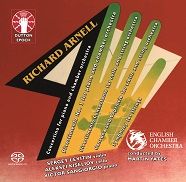ARNELL Orchestral Works
View record and artist detailsRecord and Artist Details
Genre:
Orchestral
Label: Dutton Epoch
Magazine Review Date: 10/2022
Media Format: Super Audio CD
Media Runtime: 82
Mastering:
DDD
Catalogue Number: CDLX7400

Tracks:
| Composition | Artist Credit |
|---|---|
| Concertino for Piano and Orchestra |
Richard Arnell, Composer
English Chamber Orchestra Martin Yates, Conductor |
| Canzona and Capriccio |
Richard Arnell, Composer
English Chamber Orchestra Martin Yates, Conductor |
| Divertimento No 1 for Piano and Chamber Orchestra |
Richard Arnell, Composer
English Chamber Orchestra Martin Yates, Conductor |
| Symphony for Strings |
Richard Arnell, Composer
English Chamber Orchestra Martin Yates, Conductor |
| Divertimento Concertante |
Richard Arnell, Composer
English Chamber Orchestra Martin Yates, Conductor |
Author: Jeremy Dibble
A pupil of Ireland at the RCM (1935-39), Richard Arnell was shaped musically by those inter-war influences of post-Romanticism and neoclassicism (especially of such figures as Ravel, Hindemith and Busoni) that helped form the stylistic parameters of English contemporaries such as Britten, Walton, Rawsthorne, Lambert, Berkeley, Tippett, Walter Leigh, Stanley Bate and William Alwyn. Arnell was also propelled by an American interest in his music – he was much admired by Stokowski and Herrmann – which serendipitously occurred when he found himself marooned in the US after war broke out and unable to return to Britain until 1947.
All receiving their first recordings, these five works, most of them for solo instrument and orchestra, span a period of 22 years from Arnell’s time as a student until 1961, when he was an established teacher of composition at Trinity College of Music. The exception is the earliest, the Symphony for Strings of 1939, which is hugely impressive as a student effort. Making considerable demands on its players, it is a dynamic essay full of rhythmic drive, fecund scoring for strings, contrapuntal invention and generous lyrical development, especially the expansive architecture of the first movement, which boils away like a cauldron. This is surely a work that needs to be better known within the firmament of great English string works. The Divertimento No 1 for piano and chamber orchestra, composed in America in 1939, is more reminiscent of Hindemith in its harmonic disposition and rather more spartan textures of two- and three-part counterpoint (whiffs of Mathis der Maler come and go in the slow movement).
Written towards the end of the war in 1945, the Canzona and Capriccio is less astringent than the Symphony or Divertimento, and its more amenable, indeed euphonious thematic material brought Arnell more readily before the New York public. This is an attractive short work in a lighter vein, beautifully performed by Sergey Levitin and the ECO (who are on great form throughout). By comparison, the Concertino for piano and chamber orchestra of 1947 (which Arnell finished in London) is more neoclassical in its dialogue manner between soloist and orchestra in the opening movement but returns to the rhythmic vitality of the Symphony for the vigorous second movement. Thanks to committed playing from Victor Sangiorgio, who reveals a genuine empathy for Arnell’s particular chemistry of mechanistic rhythm and decisive thematic development, these works for piano and orchestra assume a captivating life of their own. Finally, while the Divertimento concertante for cello and strings of 1961 reflects elements from many of the earlier concertante works, it has a greater coherence and fluency in its three-part construction of two shorter preludial movements and an enthralling, longer finale, full of contrasting episodes for the solo cello, nimbly executed by Aleksei Kiseliov.
Discover the world's largest classical music catalogue with Presto Music.

Gramophone Digital Club
- Digital Edition
- Digital Archive
- Reviews Database
- Full website access
From £8.75 / month
Subscribe
Gramophone Full Club
- Print Edition
- Digital Edition
- Digital Archive
- Reviews Database
- Full website access
From £11.00 / month
Subscribe
If you are a library, university or other organisation that would be interested in an institutional subscription to Gramophone please click here for further information.




